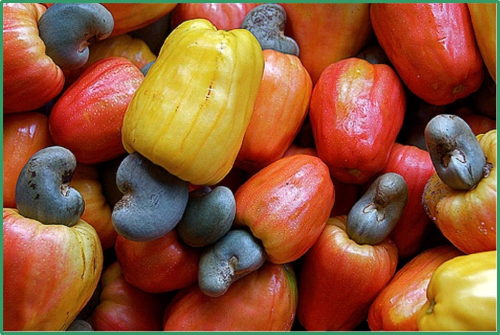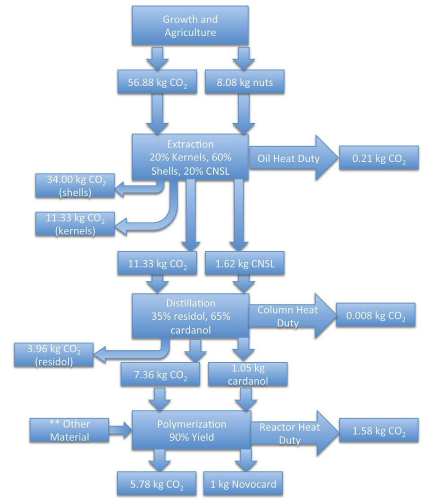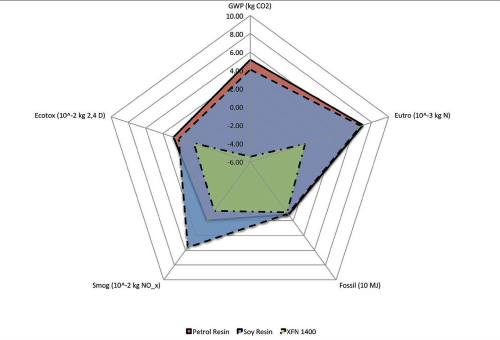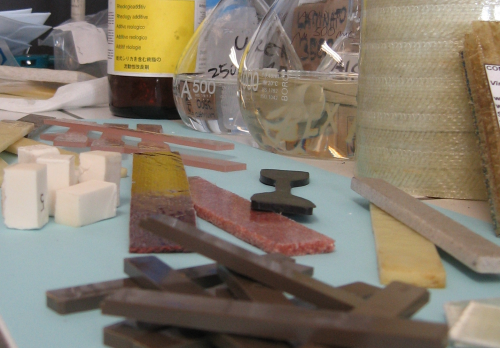




From green building materials, to the introduction of the 2011 Ford Explorer, which boasts 85% renewable and recycled content, the number of companies looking for alternatives to petroleum-based products continues to grow. Until now, converting natural compounds for end uses has proved somewhat problematic due to loss of performance properties.
However, a unique family of bio-resins has emerged with the capability to allow manufacturers to use a higher content of renewable material in a wide range of applications, without compromising performance.
Renewable content
Composite Technical Services LLC (CTS), Kettering, Ohio, USA, along with its partner Cimteclab Srl, Trieste, Italy, has pioneered a line of novolac resins called Novocard™ XFN to help the composites industry develop more sustainable products. But the material’s unique chemical structure also enhances performance properties, giving customers the value-adds they need to remain competitive.
Novocard XFN resins are made from the phenol-rich oil extracted from discarded cashew nutshells. When mixed with epoxy resin and combined with glass or carbon fibre reinforcement, the high-performing bio-resin makes a composite material with greater renewable content while minimising greenhouse gases typically associated with petroleum-based resins.
Novocard is part of a larger family of bioresins CTS calls ExaPhen™. ExaPhen, which also extracts (exa) phenolic (phen) resins from cashew nutshells, offers other grades of monomers and polymers suited for use with polyurethanes, coatings and adhesives.
“The primary difference between the ExaPhen bio-resins and other products derived from natural oil sources like soy or corn is its chemical structure,” says James Weir, product manager for CTS. “The cashew nutshell’s phenolic oil has an aromatic structure or a six-member carbon ring. This ring enables shared electrons throughout the structure resulting in high rigidity and thermal stability. Because the oil from the cashew nutshell is considered a non-edible agricultural by-product, food supplies aren’t impacted. More importantly end-use products benefit from its unique properties that have already been engineered by nature."
"Our job is to specialise and create distinctive molecular configurations and identify the most suitable markets, like composite applications for instance.”
Composite applications
Novolac resins, used as an epoxy hardener, can support a range of key composite manufacturing methods such as pultrusion, infusion, resin transfer moulding and prepreg. Epoxy formulations that incorporate Novocard resin provide improved physical and manufacturing properties when compared to traditional amine-cured systems. The resin’s aromatic structure provides inherent heat and chemical resistance to composite material, delaying the spread of flames while providing resistance to aggressive environments.
“These features make Novocard especially attractive to the construction industry where the resin is being used in pultruded rebar reinforcement,” Weir says. “The use of Novocard qualifies under the Leadership in Energy and Environmental Design (LEED) category for a composite made with renewable and recycled materials and contributes toward Materials & Resource Credits (MR-6) needed for LEED certification.”
In prepreg applications for flat or multi-dimensional structures with high strength requirements the epoxy hardener can improve impact resistance by up to 150% while maintaining tensile and shear properties.
“Novocard also has excellent fibre-wetting properties,” Weir adds.
Combining the epoxy hardener with glass reinforcement creates a composite that is less brittle and more durable. In RTM, the resin is injected or drawn into a mould containing fibres from a homogeniser under low pressure. An epoxy modified with Novocard hardeners acts as a direct replacement for a vinyl ester system, which is commonly used due to its low resin viscosity and increased corrosion resistance. Lighter weight then vinyl esters, the epoxy hardener improves energy absorption while permitting green content and reducing carbon dioxide.
Life cycle analysis
To help quantify its products’ environmental footprint, CTS recently completed a life cycle analysis study on each of its Exaphen product lines. CTS products were compared to the environmental impact of soy-based and petrol-based resin systems.
Results showed the Exaphen products demonstrated gains in eutrophication (the potential for increasing the enivronment’s nitrogen content), water intake, smog, ecological toxicity and especially in the categories of fossil fuel depletion and global warming (the total amount of equivalents of carbon dioxide released into the environment) potential.
CTS conducted the life cycle analysis to determine and evaluate every environmental impact represented by the manufacture, use and disposal of its products. The resulting data can be used by manufacturers to market products incorporating an Exaphen product as environmentally sensitive and demonstrate a commitment to sustainability.
The life cycle analysis model was constructed by grouping processes into stages that included cashew agriculture, nut shelling, cashew nutshell liquid extraction, reactive distillation of the cashew nutshell oil to cardanol and processing and polymerisation.
The life cycle analysis revealed that cashew nut trees require negligible irrigation and pesticide usage when compared to traditional crops. The trees thrive in poor equatorial soils unsuited for other crops. In addition, cashew nut trees do not deplete the soil. In a one-year period a hectare (2.5 acres) of cashew trees can sequester 6.34 tonnes of carbon dioxide. These features offer benefits that can’t easily be realised by bio-based resins derived from food sources which require large amounts of land and fertiliser to grow and are subject to fluctuating food prices.
“Some research suggests that using food crops for bio-products and bio-fuel can be even more detrimental than using petroleum-based products as land-usage changes,” Weir says.
Cashews are harvested by hand because the groves are not conducive to machinery, another factor limiting negative environmental impact. Once the nuts are gathered, cashew nutshell oil is extracted with a hot oil method using mineral oil prior to shelling. This processing method leads to waste generation of empty shells which can then be re-used as fuel. In the case of the analysis, the ability of cashew trees to sequester carbon dioxide can also be applied to the cashew nutshell oil as the cashews themselves are processed for consumption and, as a result, do not contribute to a reduction in carbon dioxide sequestration in a cradle-to-gate analysis.
The life cycle study revealed significant improvement in the area of global warming potential for all CTS products when compared to petrol-based material due to the ability of cashew trees and nuts to sequester carbon dioxide. In the case of the polyol structures, also part of the Exaphen line, the usage of fossil fuel is improved over petrol-based polyols with some improvement over soy-based polyols.
CTS takes a purified grade of cashew nutshell oil and further processes it to form products like its Novocard resin. The analysis demonstrated that Novocard resin improves fossil fuel usage substantially over both soy- and petrol-based resins. The difference is due primarily to the additional petrol-based material sources required for soy-based resins.
The study included comparisons with aluminium, which is considered a lightweight, recyclable material. Analysis revealed that aluminium is energy intensive to produce and contributes to a very high fossil fuel depletion rate. The ability to replace aluminium in material applications contributes to a reduction in both global warming potential and fossil fuel usage.
Increasing green content
Statistics support manufacturers' and consumers’ expanding interest in green products.
In 1900, 41% of the materials used in the US alone were renewable, states a study by the Environmental Protection Agency. By 1995, only 6% of the materials consumed were renewable. Today the majority of materials used in the US are non-renewable, ranging from metals and minerals to fossil-fuel derived products.
According to the study, the heads of major research institutes in the US, Germany, Japan, Austria and the Netherlands note that “unless economic growth can be dramatically decoupled from resource use and waste generation, environmental pressures will increase rapidly.”
Composites are especially suited to increasing their green or renewable content in the right applications due to their strength and light weight. The cashew nut oil-derived bio-resins offer a next step in helping composites increase their green attributes. ♦
Further information
Debi Talentino, Business Development Manager, CTS; e-mail: debi@ctsusa.us
This article was published in the May/June 2011 issue of Reinforced Plastics magazine.





